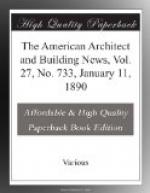were carried across the building from wall to wall,
passing through holes in the walls, and were secured
by nuts on the outside. In this state they would
have been sufficient to have prevented the further
separation of the walls by the weight of the roof,
but it was desirable to restore the walls to their
original state by drawing them together. This
was effected in the following manner: Alternate
bars were heated by lamps fixed beneath them.
They expanded, and consequently the nuts, which were
previously in contact with the walls, were no longer
so. The nuts were then screwed up so as to be
again in close contact with the walls. The lamps
were withdrawn and the bars allowed to cool.
In cooling they gradually contracted and resumed their
former dimensions; consequently the nuts, pressing
against the walls, drew them together through a space
equal to that through which they had been screwed
up. Meanwhile the intermediate bars were heated
and expanded, and the nuts screwed up as before.
The lamps being again withdrawn, they contracted in
cooling, and the walls were further drawn together.
This process was continually repeated, until at length
the walls were restored to their perpendicular position.
The gallery may still be seen with the bars extending
across it, and binding together its walls.—
Philadelphia
Record and Guide.
LOSS OF POWER BY RADIATION OF HEAT.[3]
[Illustration: The Martyrs Column, Naples, Italy.]
To him who holds the purse and pays for the coal consumed,
it is of importance that between the energy of the
burning fuel and the power developed by the engine
there should be the least possible loss. Every
unit of heat radiated by boiler-pipe, cylinder or heater
is absolute loss, and must come out of that purse.
In an electrical plant this matter is of great importance.
There is less opportunity to have results obscured.
There is, proportionally, a large possible loss between
the coal on the grate and the far end of the cylinder,
and this loss should be reduced to the minimum.
Is it not always the best economy to throw away as
little as possible, to save from waste all that
can be saved? Is not the very reason far being,
of the architect, the mechanical engineer, in fact
of every man who is paid for his advice and direction,
just this: that he shall bring to bear upon the
subject, and impart to his client honest knowledge
concerning the various matters about which he is consulted?
That he shall keep abreast of the tide of discovery
and improvement, and that upon these subjects he shall
know, not trusting to mere hearsay or to unintelligent
prejudice for his impressions.




